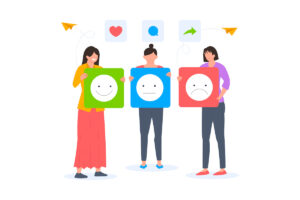A recent survey showed that only 8% of companies were providing a very integrated customer experience. What does this mean?
It’s about having a cohesive business, that cultivates close links between teams so they can share data, knowledge, and insight. It’s more relevant than ever to create meaningful customer experiences and in part, this is done by building relationships.
And customer behavior is shifting all the time, which means as a modern business, it’s important to develop a good experience for a customer before, during and after the purchase of the product.
And the key to this is moving your approach from transactional to a relationship. The deeper ‘your ‘roots” in relationships can go, the more stable your business becomes.
How can you tell which one your company represents? Let’s dive in….
Tell me what these terms mean…
Transactional can be thought of like inputting an instruction and hoping for a certain result. It’s can be a very clinical approach where a business thinks in a singular, isolated way.
If you think about this in a customer service sense and a simple customer interaction – someone asks a question and you’re just providing an answer. There’s no further detail, relationship building or any extra sparkle. It’s not memorable for a customer and taking advantage of what a privilege it is that they’re engaging with your business.
Relational approaches are about integrating meaningful relationship building into how your business approaches customer service.
When 33% of Americans say they’d switch to a different company after a single instance of bad customer support, businesses need to make good customer service a priority. So, a customer interaction that’s honest, open and transparent will be more effective.
For example, if a customer has a complaint, go above and beyond to turn this into a more positive moment and offer an incentive to come back. And this is having a more holistic and humanized way of interacting with customers and providing value to boost customer retention.
Relational marketing takes a more long-term view of the customer base to prevent their business from being part of 55% of Americans that will never visit a company again after a negative customer experience.
How to Shift from Transactional to Relational
Be in the Customer’s shoes
When making any decisions about your business and the customer experience, thinking about them from the customer’s perspective first and building out from it is crucial.
It’s their experience that’s important, so doing something that benefits a business first, might not match up with their perceptions.
Be an advocate for your customers and encourage all of your team to do so too.
Getting to know your customers and learning as much about them as possible through personas and data stops you from thinking about them in an abstract way. You want your business and the customer as close together as possible, instead of thinking of them in detached terms.
Always imagine what’s best for your customer, cos you can be sure as hell that they’ll let you know when something’s not…hello Twitter!
On the Customer’s Terms
Just because lots of people use social media doesn’t mean everybody wants to! A lot of businesses use social media as their own customer service hub, which can be cost-effective but it’s not always good for the customer.
Allowing the customer to define and choose how they interact with you means you’re putting their comfort and needs first.
A lot of customers prefer human contact, instead of a transactional message here and there with a business. If they’ve got a complex inquiry or request then this can be especially frustrating.
More humanized customer contact i.e a phone call or live chat can allow better ways to serve a customer and opportunities to build rapport. Wherever your guest pops up, make sure you make an effort on their chosen channel.
Personalization
Learning about your customers lets you provide more applicable info and better value.
This helps you to deliver content, deals, and opportunities that are more likely to be relevant based on their past customer behavior and buying habits.
You’ll turn a customer off if you’re continuing to send information that’s completely mismatched to their customer profile and what they’re interested in.
Work on creating more detailed profiles and making the most of the data that you do have about a customer or working on finding more insight with focus groups, surveys, and customer interactions.
Tone of Voice
Working on how you say things to your customers is one of the most effective ways to turn your customer engagement from transactional to relational.
Talking in a human way and leaving the robotic jargon behind can work wonders.
Making sure that all of your team are involved and fluent in your business tone of voice, means that from the top to the bottom, everyone is speaking the same language.
This means that your scripts, emails, and social content should all be using the same tone of voice, so you can help build an overall business relationship with a customer that’s consistent, coherent, and memorable.
No business wants to be anonymous to its customers, so build meaningful and lasting relationships.






